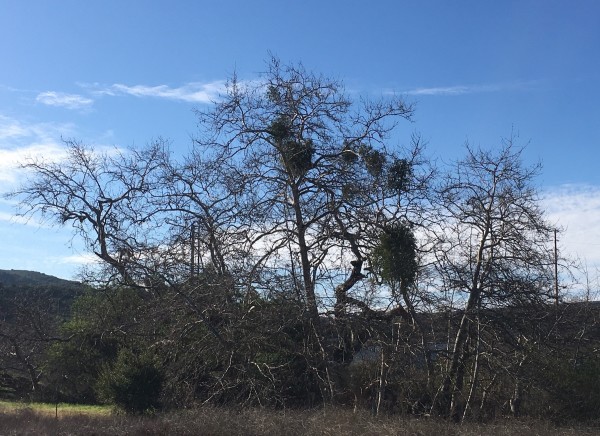When I heard the story that early settlers named Hollywood after toyon, a common Southern California shrub with bright red berries and leaves that very much resemble those of English holly, I was fascinated.
Not only that, after leaving the trails I actually remembered the name and the look of the shrub, as well as the fact that the fruit appears over the winter months – and I found it easy to identify on my hikes from then on. The Hollywood tale may or may not be accurate, but it did illustrate for me the way fun facts, or myths and legends, can help cement factual information in the sieve-like brains of people like me.
The Hollywood tale may or may not be accurate, but it did illustrate for me the way fun facts, or myths and legends, can help cement factual information in the sieve-like brains of people like me.
Here are some interesting – and random – factoids I’ve learned on the Discovery Hike in Aliso and Wood Canyons Wilderness Park from wonderful, smart Laguna Canyon Foundation volunteer hiking guides.
Fungi: Many mushrooms don’t smell too great. Some odors have been described as similar to “blue cheese,” or “sweaty feet sautéed in butter,” or “rotting fish.” But others smell like cinnamon, cucumber, or maple syrup. They last as long as several years or as briefly as 45 minutes. Let’s just say it – mushrooms are magical. (See featured photo of red-headed russula)
Sycamores: You’ll often see clumps of mistletoe on the branches – they look rather like large green pom-poms. Mistletoe is a hemi (partial) parasite which attaches to a tree via sucker roots and absorbs some water and nutrients from its host plant.
However, it also produces some of its own food via photosynthesis and provides food and shelter for birds and butterflies…a bustling ecosystem within an ecosystem. That’s so cool.
Also, during the Battle of Brandywine in 1777, a 168-year-old sycamore tree sheltered a large number of General Washington’s troops. Since then, sycamores have become symbols of protection and hope.
Acorn woodpeckers: Acorn woodpeckers store acorns by cramming them into holes they drill into trees, a favorite being the sycamore. As many as 50,000 acorns may be stored in a single tree.
 According to a wonderful book, Secrets of the Oak Woodlands, “The breeding birds are united in a gloriously complex and extremely rare social structure known as polygynandry.” This means breeding females may mate with any or all of their partners, and the same for males. All the females lay their eggs in the same nest and the whole clan cooperates to raise the young.
According to a wonderful book, Secrets of the Oak Woodlands, “The breeding birds are united in a gloriously complex and extremely rare social structure known as polygynandry.” This means breeding females may mate with any or all of their partners, and the same for males. All the females lay their eggs in the same nest and the whole clan cooperates to raise the young.
Avian hippies practicing free love?
Woodrats: And don’t get me started on woodrats. They’re amazing creatures. On my very first Discovery hike, we came across a large but unassuming pile of sticks and vegetation – turns out it was a woodrat nest.
 Their multilevel, complex nests consist of rooms and corridors divided into areas for sleeping, pantries for storing food, and nooks for nursing. The woodrats may cover the entrance with fragrant sage to hide their scent from predators.
Their multilevel, complex nests consist of rooms and corridors divided into areas for sleeping, pantries for storing food, and nooks for nursing. The woodrats may cover the entrance with fragrant sage to hide their scent from predators.
Smart creatures, they nibble the edges of California bay laurel leaves to release oils that repel fleas and nest parasites. And many generations of woodrats will use the same nest, which may last as long as 60 years.
Well, I started with Hollywood, so let’s end with Hollywood.
Red-tailed hawks: Red-tailed hawks like to build their nests up high, on trees up to 120 feet above the ground. They have a wingspan of four to five feet and can range from blackish to rufous-brown and white.
These elegant birds emit a thrilling, raspy scream that sounds exactly like the sound any raptor should make – or so Hollywood directors think, apparently. Whenever a hawk or eagle appears onscreen, no matter what species, I’m told the shrill cry on the soundtrack is almost always a red-tailed hawk.
The Discovery Hike: Take part in the Discovery Hike, where you’ll learn fascinating facts, including Native American uses for coyote gourds, otherwise known as stink gourds; the reason why there are so few oaks older than 40 – 50 years in this part of Orange County; and which plant’s leaves are said to be useful in repelling fleas and bedbugs.
While guided hikes are currently suspended due to COVID-19 precautions, please follow us on Instagram, Twitter and Facebook, where some of these answers may be revealed.
During non-COVID-19 times, the Discovery Hike takes place every other Wednesday at Aliso and Wood Canyons Wilderness Park. Meet at Canyon View Park at 8:30 a.m. Interested in taking the hike on your own? Follow Wood Canyon Trail to Wood Creek Trail to Coyote Run back up to Wood Canyon Trail. Happy hiking!
Photos by Volunteers Lynette Brasfield and John Foley and LCF Staffers Alyssa Moreno and Paula Olson
